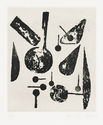
19th, 20th & 21st Century Fine Prints
707-546-7352 · fax 707-546-7924 · web: www.annexgalleries.com · email: artannex@aol.com
Warja Honegger-Lavater Biography
Warja Honegger-Lavater
Swiss
1913–2007
Biography
Warja Lavater (28 September 1913 – 3 May 2007) was born in Winterthur, Switzerland on September 28, 1913. Lavater spent the first nine years of her life in Moscow and Athens, Greece. In 1922, her mother (the author Mary Lavater-Sloman) and father Emil Lavater (an engineer) settled the family back in Winterthur. After attending high school, Lavater studied graphic arts in Zurich from 1931 to 1935 at the School of Applied Arts. It was here, in 1932, she began studying under Ernst Keller in a class of 28 of which 7 were women. Later in life, Lavater recalled this training:
What we were learning was design, and so we began with the most important thing, drawing. Where do you put a sign in a rectangle? What is the standard solution to this exercise? Should the strongest element be the sign or the drawing? How can both be distinguished at a distance, yet integrated in a composition?
Studying in Stockholm, Basel, and Paris, she opened her own studio for applied design in Zurich in 1937 with Gottfried Honegger, her future husband. It was here that Lavater embarked on her first profession as a designer of symbols, logos, and trademarks. Among her initial creations were the three keys logo of the Swiss Bank Corporation - which is now used by its successor, Swiss global financial services company UBS AG and the logo for the Swiss National Exhibition of 1939.
After marrying Honegger in 1940, she bore two daughters: Bettina (1943) and Cornelia (1944). From 1944 to 1958 she worked extensively with the young person's magazine Jeunesse designing the covers, supplying illustrations, and being responsible for typography.
Moving to New York City in 1958, she began designing scientific illustrations for Dell Publishing Visual series. It was during this early period in New York that Honegger-Lavater became influenced by American street advertising and began to utilize pictograms as graphic representations of linguistic elements in her work. In 1962, the New York City Museum of Modern Art published her William Tell as a single sheet lithograph, accordion folded in the "Leporello" style, with a legend listing the meanings of the various symbols (e.g., a single blue dot represents William Tell). The story proceeds chronologically as the book unfolds, and is told entirely by using the symbols without words. She produced a growing number of similar works throughout the rest of her career.
By 1995 she was creating videos of colors and symbols moving across a screen, set to music.
At the time of her death on May 3, 2007 she was retired and residing outside of Zurich.
Taken from her biography on Wikipedia.

